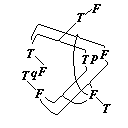 q", "p" and
"q" connected together in the form
"(p
q", "p" and
"q" connected together in the form
"(p  q) . (p) :
q) . (p) : : (q)" give a
tautology shows that q follows from p and
p
: (q)" give a
tautology shows that q follows from p and
p  q.
q.
That "(x) . fx : : fa" is a tautology shows that fa
follows from (x) . fx, etc. etc.
: fa" is a tautology shows that fa
follows from (x) . fx, etc. etc.

and the co-ordination of the truth or falsity of the whole proposition with the truth-combinations of the truth-arguments by lines in the following way:

This sign, for example, would therefore present the
proposition p  q. Now I will proceed to inquire
whether such a proposition as ~(p . ~p) (The Law of
Contradiction) is a tautology. The form "~
q. Now I will proceed to inquire
whether such a proposition as ~(p . ~p) (The Law of
Contradiction) is a tautology. The form "~ " is written
in our notation
" is written
in our notation

the form "
 .
.  " thus :--
" thus :--

Hence the proposition ~(p . ~q) runs
thus :--

If here we put "p" instead of "q" and examine the combination of the outermost T and F with the innermost, it is seen that the truth of the whole proposition is co-ordinated with all the truth-combinations of its argument, its falsity with none of the truth-combinations.